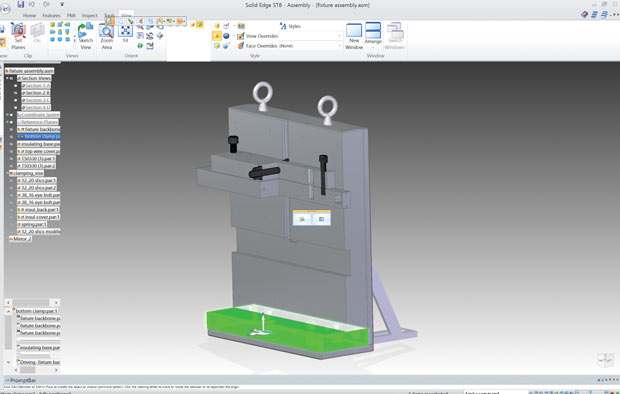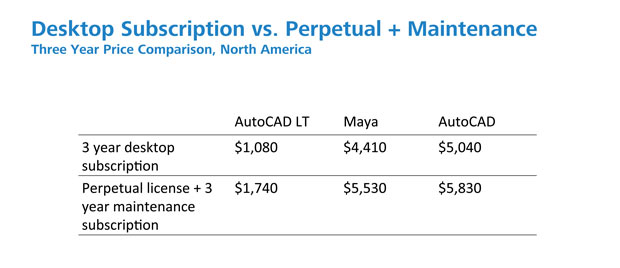
Ryan Spoering, who runs consultant business Lab Machinist Solutions, uses Solid Edge on subscription to turn his clients’ ideas into 3D CAD for prototyping. Image courtesy of Ryan Spoering.
Latest News
March 1, 2016
When people are leasing a car, they tend to get a model that’s much nicer than what they can afford to buy,” says Cristiano Sacchi, co-founder of the online design software reseller Novedge. He suspects the same might be true of people renting software. “People might get a more sophisticated software package when the barrier of entry for cost is much lower.”
Perpetual licensing was once the only way to buy CAD. The buyers paid an upfront cost of a few thousand dollars, along with an annual maintenance fee to get regular updates. Even when Salesforce.com’s pay-as-you-go offerings were sweeping through the enterprise, CAD held out. But now that is changing.
 A subscription to Autodesk products is initially cheaper, but unlike perpetual licenses, the software will not continue to operate if the subscription is not maintained. Information courtesy of Autodesk.
A subscription to Autodesk products is initially cheaper, but unlike perpetual licenses, the software will not continue to operate if the subscription is not maintained. Information courtesy of Autodesk.At the end of January, Autodesk stopped selling perpetual licenses for its individual software titles. In July, it plans to stop selling perpetual licenses for its popular software bundles, such as the Autodesk Product Design Suite and Building Design Suite. (The perpetual licenses already sold prior to these deadlines remain valid; owners will continue to receive upgrades as long as they continue to pay their maintenance fee.)
Autodesk’s rivals aren’t discontinuing their perpetual models, but they have begun offering subscriptions. In 2013, Siemens PLM Software put its mainstream CAD program Solid Edge on subscription. Last November, PTC put its entire portfolio on subscription. Dassault Systèmes SOLIDWORKS was previously only available for perpetual licensing. However, the company announced at the recent SOLIDWORKS World conference it plans to offer the product under short-term licensing. It will also be offering SOLIDWORKS Conceptual Designer and Industrial Designer in a similar fashion. This January, it previewed X-branded products—X Drive and X Design—also to be made available in short-term licenses.
Dan Schulist, general manager of Autodesk reseller MasterGraphics, feels the pressure subscriptions are having on resellers. “The customers now have an easy out,” he says. “They’re no longer obligated to put down a huge investment and figure out how to make it work. We need to help them make it work.”With perpetual licensing, the customer and the reseller are in a committed relationship once the transaction is processed. With a subscription, the customer can walk away without the loss of an initial investment; therefore, the reseller must continually prove its value to retain the subscriber. “CAD technology is very complex. Most customers only use a fraction of the software’s capacity,” Schulist says. “We can help them discover the full extent of the software’s potential.”
It’s not clear what the long-term ramifications of subscription CAD software will be. “The truth is, we’re learning, figuring out things as we go,” Sacchi says. Resellers continue to be the frontline of CAD sales. Their strategies to weather the transition from perpetual to subscription economy could have profound effects, not only on their own future but also on the user experience.
The Number Game
At about $100 per user per seat, subscription licensing is a departure from the previous model. For a start, the reseller’s profit margin is much smaller; the surefire way (perhaps the only way) to remain competitive is to become efficient at volume sales.
Franco Folini, co-founder of Novedge, compares selling CAD subscriptions to selling SOLIDWORKS student editions, currently listed for $86 on Novedge’s online catalog. “We don’t expect to make a lot of money on them,” he explains. “But we can’t subsidize the operations at a loss either. We just make a little bit of profit on each sale. For this kind of product, we need to have a super-efficient, highly automated system.”
The Exploratory Buyers
MasterGraphics’ Schulist estimates that 60% of its business comes from the manufacturing sector, the rest from architecture, engineering and construction. The company has been selling Autodesk products throughout the Midwest since the 1990s. It is currently a platinum partner of Autodesk.
Schulist recalls some existing customers stocking up on perpetual licenses before Autodesk’s cutoff date arrived. “These are established businesses that know they’ll be using the software indefinitely, and prefer to own the software perpetually,” he says.
While subscription dramatically lowers the cost of entry, some see the cumulative monthly or yearly subscription fees over time as an economic disadvantage. By Autodesk’s own calculations, a three-year desktop subscription of AutoCAD comes to $5,040, whereas a three-year maintenance and a perpetual license of AutoCAD comes to $5,830. Keep in mind, however, that the subscription fee of $210 a month or $1,680 a year (current published price for AutoCAD) will continue indefinitely. By comparison, someone who owns a perpetual license of AutoCAD could continue to pay the nominal maintenance fee (not published, available through resellers) to continue receiving upgrades. Therefore, over a period of six, seven or 10 years, the total spent on subscription could add up significantly higher than the perpetual license and maintenance combo.
Responding to DE’s Virtual Desktop blog post “Autodesk Will Only Sell Subscription Licenses for Desktop Products After February 1, 2016,” one reader commented: “I had considered upgrading our AutoCAD platform that complements our use of SOLIDWORKS for design, but we’ll definitely pass on the cloud-centric subscription model and just stick with their legacy software as long as we can make it work. This one-size-fits-all pricing is simply impossible for us to justify for continued use.”
While some users are leery of the subscription model, MasterGraphics is also uncovering new markets. “Our newer customers are younger startups,” Schulist says. “They want a lower cost of entry. They don’t want to shell out a lot of money for a program only to find out later that’s not what they need.”
Novedge is having a similar experience. “We’re starting to see smaller, newer customers,” Sacchi says. “If you can’t afford to buy a professional package like Maya, you can’t produce work with a certain kind of quality. But now, you can subscribe to it at a much lower price. Ideally, we’ll see people who couldn’t afford to buy the professional software packages becoming subscribers.”
Monthly or quarterly subscriptions can be adjusted to match the rise and fall of project needs; by contrast, perpetual licenses are permanently installed, with a fixed cost for annual maintenance even when the licenses are not in use.
Catering to the On-Demand Crowd
MasterGraphics’ value-add offerings mirror the changing attitude. “We give customers the flexibility to choose what they want, when they want it,” Schulist says. “We’ve always offered classroom training, but we now produce more online and offsite trainings. We also break longer trainings into smaller modules.”
Novedge’s Sacchi says subscription licensing is a precursor to a new kind of CAD software. “Right now, when you subscribe, you’re essentially getting the same product as the perpetual software,” he points out. “But I think over time the products will include much more add-on services. With more timely upgrades, products will become alive.”
Both vendors and resellers recognize the move to subscription comes with certain risks. But the risk of abstaining from subscription licensing may be far greater. “This is the way the market is going, the way software will be sold, what the customers demand and want,” Schulist says. “We need to get in line with it.”
More Info
Subscribe to our FREE magazine, FREE email newsletters or both!
Latest News
About the Author
Kenneth Wong is Digital Engineering’s resident blogger and senior editor. Email him at [email protected] or share your thoughts on this article at digitaleng.news/facebook.
Follow DE






